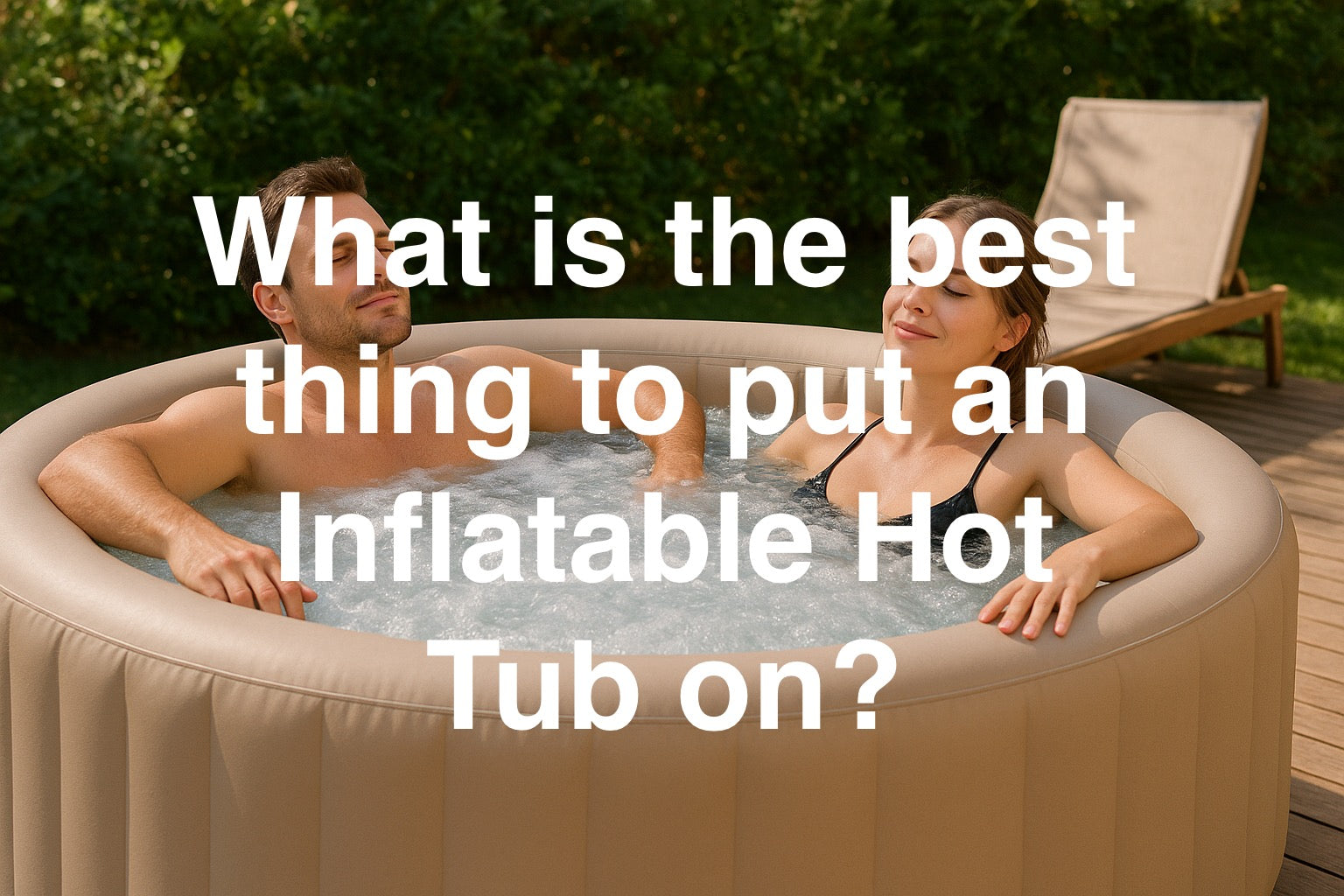
What is the Best Thing to Put an Inflatable Hot Tub On?
Inflatable spas are brilliant—until you plonk one on grass and sink like quicksand.
The short answer? A flat, sturdy base like concrete, decking, or a hot tub mat.
But here’s the thing: the surface you choose doesn’t just affect how comfy your spa feels—it decides whether it lasts a few months or a few years. Stick with us, and we’ll walk you through the best options (and the mistakes to dodge) so your family hot tub time stays safe, relaxing, and drama-free.

The Importance of a Proper Base for Your Inflatable Hot Tub
Getting the base right isn’t the “boring bit” before the fun begins—it’s what keeps your inflatable spa safe, steady, and enjoyable. Think of it like a mattress. Choose well, and everyone sleeps easy. Pick badly, and you’ll regret it every single night.
Why a Stable and Level Surface is Crucial
When filled, your inflatable hot tub weighs as much as a small car. If it’s plonked on an uneven or sloping patch of ground, things can get wobbly fast. A tilted spa isn’t just awkward—it’s unsafe and puts stress on the walls.
Preventing Damage to the Hot Tub
Rocks, roots, or rough ground can cause punctures you won’t notice until you’re knee-deep in bubbles and water is trickling into the lawn. A protective mat or ground cloth acts like a hot tub shield, keeping the base safe from sneaky damage.
Ensuring Proper Function and Longevity
Level ground means even pressure, which helps the pump and heater work properly. In the long run, a solid base keeps your spa in better shape, so you’re not shelling out for repairs or a replacement when you could be splashing with the kids.
Understanding the Weight of a Filled Hot Tub
It’s easy to underestimate just how heavy an inflatable spa gets. A 4–6 person model filled with water and people can top 1,000kg—that’s more than a hatchback on your patio.
The Combined Weight of Water and People
Picture this: 800 litres of water plus a few adults enjoying a soak after bedtime stories. That’s serious weight. If the surface isn’t built for it, expect sinking, shifting, or worse—a spa that tips out your Saturday night soak.
Top Surface Options for Your Inflatable Hot Tub
Now for the fun bit—choosing the right home for your spa. Each surface has its perks and pitfalls, so let’s break them down.
Concrete
Pros: Durability and Stability
Concrete is the no-nonsense option. Strong, reliable, and able to handle the weight without batting an eyelid. If you’ve got a level patio, you’re laughing.
Cons: Cost and Permanence
On the flip side, concrete isn’t cheap to pour, and once it’s in, it’s staying put. Not great if you change your mind about spa placement.
Decking
Pros: Aesthetics and Comfort
Decking looks gorgeous. It softens the feel of your outdoor space and blends seamlessly with garden design. Imagine stepping straight from patio doors to your spa—it’s a lifestyle upgrade.
Cons: Potential for Damage and Structural Requirements
But here’s the catch: decking needs to be reinforced. Without the right support, all that weight can bow the boards or worse. Always check load-bearing limits before you set up.
Gravel
Pros: Affordability and Drainage
Gravel is budget-friendly and brilliant for drainage. With proper prep—like a level bed and a layer of sand—it can work surprisingly well.
Cons: Risk of Punctures
Leave sharp stones lurking underneath, though, and you’re inviting a puncture disaster. Think of gravel as a “DIY with care” option.
Pavers or Patio Slabs
Pros: Solid Support and Attractive Finish
Slabs offer a neat, durable base and look smart in most gardens. They give your spa a polished, permanent home.
Cons: Leveling Challenges
The challenge? Getting them perfectly level. If you’re a perfectionist, this might involve more sweat and spirit levels than you’d hoped for.
Specialized Hot Tub Pads and Mats

Pros: Insulation, Portability, and Ease of Installation
These are designed for the job. Quick to install, portable if you move, and they even add insulation to keep your water warmer.
Cons: May Require an Additional Sub-Base
They do need a solid, flat surface underneath. Pop them on bumpy ground and you’ll still have problems.
Preparation and Installation: A Step-by-Step Guide
Before you start filling, make sure your spa’s got the right foundations. A little prep now saves a lot of hassle later.
Site Selection and Ground Preparation
Finding a Suitable Location (Indoors vs. Outdoors)
Indoors can work (a conservatory or garden room), but drainage is a headache. Outdoors is simpler—just make sure the spot is level, accessible, and close to power.
How to Level an Uneven Surface
Uneven lawn? Use sand, soil, or a proper base layer to level it out. Don’t be tempted to “make do”—a wonky base equals a wonky spa.
Adding an Extra Layer of Protection
Using Ground Cloths or Tarps
Think of a ground cloth as the spa’s welcome mat. Cheap, easy, and a lifesaver when it comes to puncture prevention.
The Role of Foam Insulation Boards
Want extra comfort and lower heating bills? Foam boards give you both. They create a cosy, insulated layer under your spa.
Related Considerations for Your Inflatable Hot Tub Setup
The Importance of Drainage
Water will escape—splashes, overflows, or a bit of rain. Without drainage, you’ll end up with a muddy mess around your spa.
Accessories to Enhance Your Hot Tub Experience
Steps and Surrounds
No one wants to clamber in like they’re scaling a fence. Steps make entry safer, and surrounds can transform your spa into a real garden feature.
Covers and Lids
Keep the heat in, the leaves out, and curious little hands safe. A quality cover pays for itself in saved heating costs alone.
How to Prepare Your Hot Tub for Winter
When temperatures drop, don’t leave your spa out to freeze. Drain it, clean it, and store it properly. Come spring, it’ll be ready for action.
Key Takeaways
-
Always set your inflatable spa on a flat, level surface to avoid wobbling or damage.
-
Concrete, decking, pavers, mats, or properly prepared gravel are the best options.
-
Add a protective layer like a tarp, foam board, or hot tub mat for safety and insulation.
-
Consider weight, drainage, and access to power before choosing your spot.
-
A well-prepped base means a longer-lasting spa and stress-free family soaks.
Conclusion

At the end of the day, your inflatable hot tub isn’t just about bubbles and bliss—it’s about making family downtime easy and enjoyable. Choosing the right base might feel like a faff now, but it’s the secret to keeping your spa safe, steady, and ready whenever you are.
Whether you go for concrete, decking, mats, or a DIY option, think of it as setting the stage for countless evenings of laughter, chats, and the odd sneaky glass of fizz. Do the groundwork right, and your spa will reward you with years of happy memories—no sinking, no punctures, no regrets.
Have you checked out our other posts?
Can You Put An Inflatable Spa On A Deck?
Do I Need To Put Anything Under An Inflatable Hot Tub?
Can A Balcony Hold An Inflatable Hot Tub?
Is It Safe To Put An Inflatable Hot Tub In The Garage?
Can An Inflatable Hot Tub Be In The Sun?
Where Is The Best Place To Put An Inflatable Hot Tub?



Leave a comment